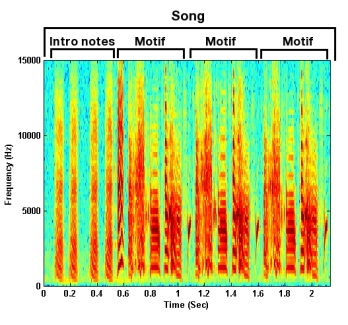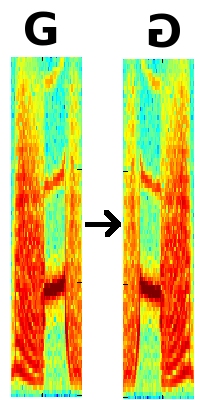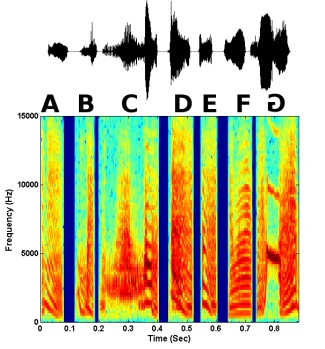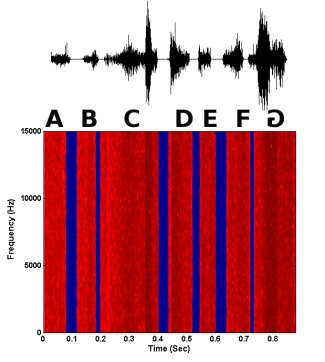Music to Zebra Finch Ears: Which Acoustic Cues Do
Zebra Finches Attend to When Listening to Song?
Beth Vernaleo - bgoldman@umd.edu
Robert J. Dooling - dooling@psyc.umd.edu
University of Maryland
Neuroscience and Cognitive Science Program, Dept. of
Psychology
College Park, MD
20742
Marjorie R. Leek -
marjorie.leek@va.gov
National Center for Rehabilitative Auditory Research
Portland VA Medical Center
Portland, OR 97239
Presented Wednesday morning, April 21, 2010
159th ASA Meeting, Baltimore, MD
Birdsong has long served as a model for vocal development
and communication. Zebra finches are a particularly interesting model because
they sing just one song their entire lives, and they sing this song with little
variation from rendition to rendition. Male zebra finches sing to other males
to defend their territories and to females for mating displays. Thus,
perception of song is important for species survival.

Figure 1. A male zebra finch
Songs consists of bursts of sounds (syllables), separated by
silence (intervals). A motif is a specific ordering of syllables. Motifs range
from 3 to 8 syllables long, and each syllable in the motif is unique. Zebra
finch songs consist of several introductory notes, followed by a few renditions
of the motif, sung in a very repetitive manner.
Sound 1. A typical zebra finch song
If we take a closer look at a single song motif, we can see
that each individual syllable is acoustically complex. Each syllable contains an
amplitude envelope (loudness cues) spectral structure (pitch, timbre, or
frequency cues) and temporal fine structure (millisecond phase cues), which
result in a set of syllables all of which are acoustically distinct. Are all of these cues equally important for
song perception?

Figure 2. A zebra finch song motif
Sound 2. A zebra finch song motif
Previous work has shown that zebra finches are quite good at
discriminating changes to their song motifs, specifically temporal reversals of
single syllables (i.e., playing syllables backwards). Below is an example of this type of change.
To find out which acoustic cues zebra finches are listening to when they make
these discriminations, we tested discrimination of reversals of single
syllables in a few types of modified
song motifs, which were designed to isolate these acoustic cues.
Figure 3. An example of a temporal reversal of a single syllable
with a song motif

Figure 4. A magnification of the same syllable and it's reversed
version
Birds were tested on discrimination tasks, in which they had
to discriminate between two sounds: the original song motif and a song motif
with a temporally reversed syllable. The testing setup consists of a cage with
two LEDs (red and green) placed on the wall and a speaker overhead through
which sounds are played to the bird. The original song motif was played as a
repeating background, and the bird had to peck the left (red) observation LED
as this motif is being played. At random times, a target stimulus (the changed
motif) was played to the bird instead of the original motif. If the bird detected
a change from the original motif, he was trained to peck the right (green)
report LED in order to receive a food reward. If he did not detect a change,
then he was to peck the left LED. By recording which keys the bird pecked
during the changed motifs, we could determine which changes the bird could
detect, how quickly he could detect these changes, and which changes the bird
seemed unable to detect. Below is a video showing the experimental setup and a
bird completing this task.
Video. A video of a bird during the discrimination task
Syllable reversals were tested in natural motifs, as well as
synthetic motifs in which certain acoustic cues were removed. One type of
synthetic motif (noise motif) consisted of the motif amplitude envelope filled
with random noise. This type of motif removes any spectral structure of
individual syllables, and the main cue that remains is amplitude envelope
(short-term loudness cues). A second type of synthetic motif (Schroeder motif) consisted of Schroeder
harmonic waveforms in which only fine structure changed when the waveform was
temporally reversed (i.e., no pitch or short-term loudness cues). The amplitude
envelope and spectrum remained the same across time. However, there were phase
changes across frequencies such that the starting phase of each harmonic
increased. Thus, there was an upward sweep of phase across frequencies that
became a downward sweep when the harmonic was temporally reversed. Examples of
a syllable reversal in a natural motif and both synthetic motifs are shown
below. In each case, the last syllable G is reversed. Both the waveform of the
motif and the spectrogram are shown.

Figure 5. A
natural motif in which the last syllable is reversed in time

Figure 6. A synthetic noise motif in which the last syllable is
reversed in time

Figure 7. A synthetic Schroeder motif in which the last syllable is
reversed in time
Birds are best at temporal reversals of syllables when all
acoustic cues are present, in the natural song motif (shown in blue). When
spectral structure is removed, but the amplitude envelope remains intact, birds
show a decrease in performance but are still able to discriminate most syllable
reversals. When only phase information is present, birds perform almost as well
as they do on natural motifs. This is surprising, because phase changes take
place over milliseconds, whereas envelope changes take place over much slower
timescales. Male zebra finch performance on one song motif is shown below.

Figure 8. Male zebra finch performance for single syllable
reversals in natural song motifs, noise motifs, and Schroeder motifs
This suggests that birds can use the multiple acoustic cues
available to them for the task, but they are best when all cues are
available. This is reminiscent of human
speech, in which there are multiple redundant cues available for speech
recognition. However, one difference is
that zebra finches are able to use either envelope or temporal fine structure
cues alone to discriminate changes in syllables. Humans on the other hand,
primarily use envelope cues for speech recognition. Humans can easily
understand sentences when the speech envelope is filled with random noise, but
cannot understand speech when the envelope is removed.
This ability of zebra finches to use temporal fine structure
suggests that it is an important cue for song perception. In human speech perception, temporal fine structure
is necessary for understanding speech in noisy environments. Perhaps it serves
a similar purpose for zebra finches. Zebra finches live in wooded areas, among
many other birds that share similar songs. Perception of temporal fine
structure in song may be necessary for singer identification, and transmission
of song over distances.